Whether you are to repair your kitchen sink drain or install a newer one, you must know about the standard sink drain size.
The same goes for the bathroom sink as well. A standard sized drain is available in every local hardware store, and it’s not too complicated to understand why you might need two different sizes for the bathroom and kitchen.
Your kitchen sink has to undergo lots of cleaning and stuff, which makes it very important to use the right drain size so that it doesn’t get clogged.
However, compared to a kitchen sink, most bathroom sinks don’t endure much pressure.
If you have decided to take care of plumbing works for your house, this article will tell you about the right size, and other pieces of information you need to know.
Kitchen Drain Parts
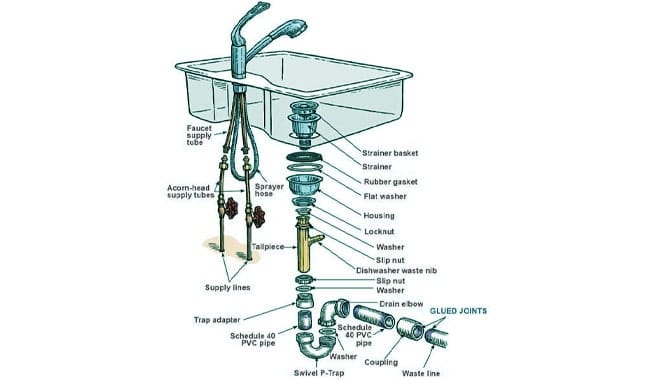
Before jumping onto the size, let’s know about the drain parts of your kitchen sink. There are several parts in the drain for different purposes.
The very first one is known as a drain basket that is fitter into the drain hole. It also includes a bowl on the hole, washer, locknut, and a threaded piece of pipe.
The washer and locknut make sure the drain is well-secured on the sink.
Furthermore, the drainpipe attaches to the threaded pipe that is below the basin on the drain. And this is the part you need to be concerned about when replacing a drain pipe or hole.
Standard Kitchen Sink Drain Size
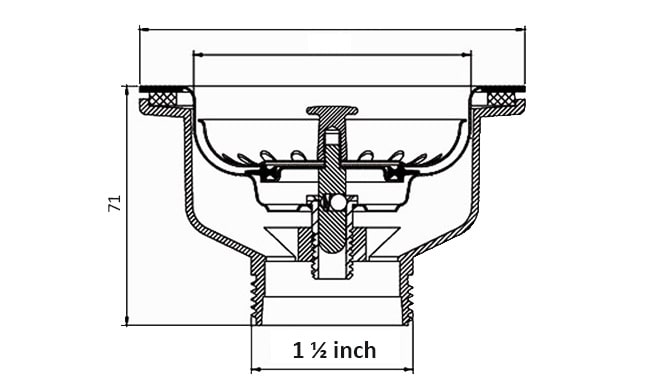
When you turn on the tape, you expect it to clean your kitchen sink to drain all the water along with other stuff as well.
It primarily does one function, drain off the tap water from the sink surface. In fact, it does most of the draining of the entire houses.
That’s why you must keep the drain clear to be able to flow water without obstacle. This has to do a lot with the right drain size. There will be good water flowing if you can determine the ideal size.
Getting an improper one will require you to unclog the sink more often, followed by frequent repairing.
Regardless of your kitchen sink type, there are standard sizes available. Considering availability as well as all-kitchen use, you should stick to the recommended size, whether it’s installing a new one or any repair.
Now, let’s come to the main topic. The standard kitchen sink drain hole size is about 1 ½ inch. This is the inside diameter of the hole, not the pipe.
Standard Kitchen Sink Drain Pipe Size
Don’t get confused with the hole size and the actual pipe size.
Inside the pipe, there should be 1 ½ inches hole. But as far as the pipe or standard size PVC for sink drain is concerned, it’s 2 or 3 ½ inches in diameter.
It’s the measurement that surrounds the center of the drain from both sides.
There is a bowl-shaped drain strainer inside the drain mount that has to match with this size. It seals the drain mouth so that you can flush the water to the bowl.
The hole size is smaller than the drain size. Because the drain pipe has to fit inside the drain hole and connect properly for allowing the water to flow without leaking.
So, if the hole is 1 ½ inch, you need to get a pipe of 2 inches; similarly, 1 ½ inches pipe is required if the hole is 1 ¼ inch.
All other fixtures in your house, including the kitchen sink drain pipe, have local or governed plumbing codes.
Whether it’s international or uniform plumbing code, these codes are accepted worldwide as a standard to ensure safe and correct plumbing.
Standard Bathroom Sink Drain Size
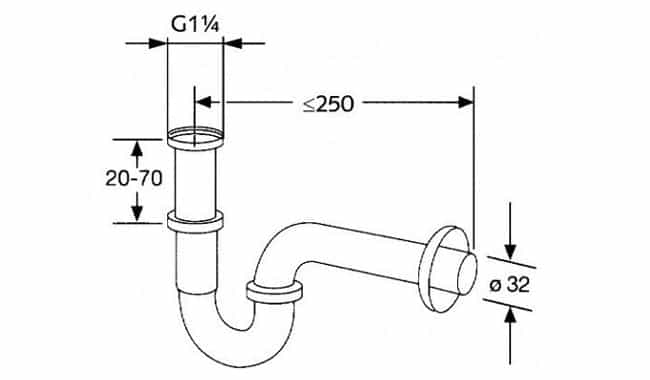
The sizes of the bathroom sink and kitchen sink aren’t the same. Although they work the same way, we technically use them for different purposes.
A kitchen sink is what deals with all cleaning and stuff that include food particles and other substances. But we don’t use the bathroom sink for cleaning.
You mostly use it for washing your hand and face with facewash and hand sanitizer, shaving, and brushing your teeth.
Due to this, a kitchen sink has a relatively higher chance of getting clogged by food particles, which isn’t the case with the bathroom sink.
Therefore, the standard size for the bathroom is a bit smaller.
If you are to install a new bathroom sink drain hole or repair the damaged one, go to any local hardware and supplies store, and ask for 1 ¼ or 1 1/5 inches drain hole. These are the most commonly used sizes. You can even go for a 1 ½ inch size if necessary.
So, even though there are different sizes of drains for your bathroom sink, according to the international code council, the standard is 1 ¼ inch.
Even if you get a new faucet for the bathroom sink, you need to buy a drain of these sizes. Most faucet manufacturers provide a standard size drain with the product; in case you don’t get any, you know which one to get.
Bathroom Sink Pipe Size
You probably already guessed what will the pipe size be. To fit a 1 ¼ inches drain, you will need 1 ½ inch PVC pipe so that there is no water leakage regardless of the water pressure.
In other words, the drain size should be smaller than the overall diameter of the drainage hole.
Also, make sure that the drain flange is wider so that the hole is properly covered. You will hardly find a bathroom sink drain hole above 1 ¾ inch.
Regulations Aren’t the Same Everywhere
Depending on where you live, you might see the difference in sizes. ICC standard 1 ¼ inches size is followed by most municipalities.
Where cities such as Minnesota, Richfield, etc. recommend their citizens to use 1 ½ inch drain size, and require getting a drainage hole of the same size.
Before attempting to do any modification, be sure to check local building codes for the plumbing of your area.
A Few Things Related to Kitchen and Bathroom Sinks
Apart from just the drainpipe, there are other necessary parts that complete the entire installation of your sink.
If you are about to get it done all by yourself, you should know about them also.
Trap
In each and every sink, there is either a P or S-shaped trap attached to the drain.
It’s actually a curved piece of PVC pipe that either stays underneath the basin or goes into the wall. In most modern houses, plumbers prefer using P-traps.
If the trap is connected to a horizontal pipe that goes underneath the basin and then into the wall, using P-trap is recommended.
On the flip side, when the pipe is extended vertically into the floor, in that case, you need to use an S-trap.
Pipe Composition
You will come across various types of kitchen sink pipes, made of different materials. White PVC pipes are considered best among them all due to its reliability and durability.
This pipe is dominating over older cooper made sink pipes.
More so, you might find cast iron or galvanized steel pipes in the market. But if you consider durability, ease of installation, and taking apart to unclog, nothing beats PVC pipes.
Connection to the Sink
The sink basket is connected to a tailpiece through a locknut. If it’s a double-sink, there is an elbow attached to the tailpiece, which is located underneath the left sink.
This elbow makes a connection between the basin and the drainpipe of the other sink through a T-fitting, which later goes down to a P-trap or S-trap either horizontally or vertically into the floor.
Drain Pipe Connection
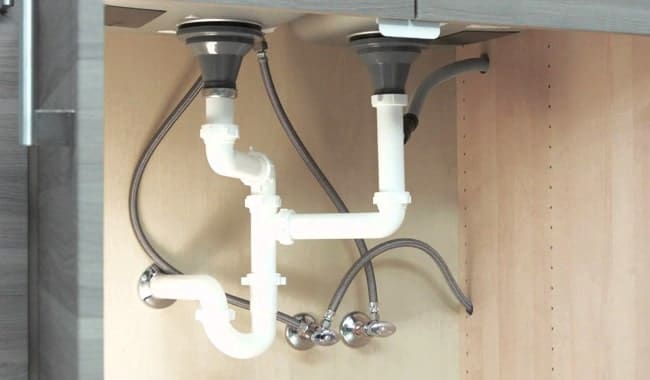
Your kitchen drainpipe connects right to the drain underneath the sink. A secure connection is made between the drain to the sink through a locknut, as I have mentioned earlier.
There is a connector either made of brass or solid metal on your PVC pipe that connects the drain pipe. Once you are done attaching them, tighten it to make the connection secure.
Drain Line Pipes
The P-trap is connected to the main drainage pipe through the drain pipe. There are drainage pipes of about 1 ½ to 2 inches. You might need to reduce bushing to be able to connect both the pipes together.
Effortlessly, you can bush a 1 ½ inches pipe to a 2 inches pipe.
Secure the 1 ½ inches pipe facing towards the kitchen drain pipe, and 2 inches pipe to the main drainage pipe.
Bar Sink Drain Openings
A bark sink drain is used when the bathroom sink endures heavy-duty usage, but not similar to a kitchen sink. The diameter of these drains is 2 inches.
You need to either get a 1 ½ or 1 ¼ inches tailpipe to be able to connect to it. A P-trap pipe is required to connect the bar sink drain to the main drain line.
How to Unclog Your Kitchen Sink without Calling a Plumber
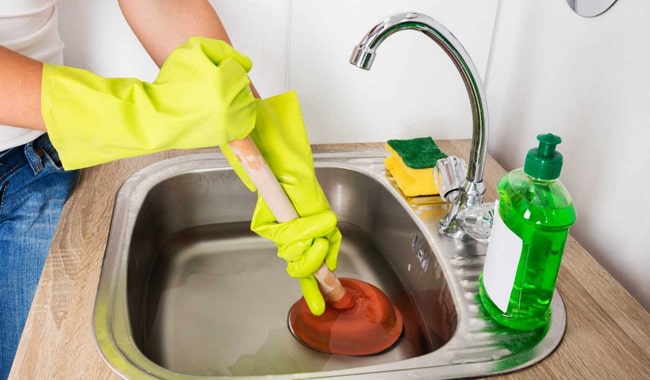
The clogged kitchen sink is something that pretty much everyone has to deal with.
There are reliable home ways to unclog your kitchen or bathroom sink. Check out these top unclogging tips.
Method 1: Boiling Water
This method requires minimal effort from you and is the least expensive off all; so, it’s worth giving it a try in the first place.
Place one pot of water on the stove and boil it properly. While it’s boiling, you try to remove water from the sink as per your ability; use a small pot or mug to get the standing water out of the sink.
Now, pour boiled water into the sink, and give it some time to unclog. If it doesn’t work, let it cool and get the water out of the sink, and try pouring hot water again.
You may also try adding half a cup of table salt in the boiled water. Repeat the process several times, this should work if the stoppage isn’t unusual.
Method 2: Vinegar with Baking Soda
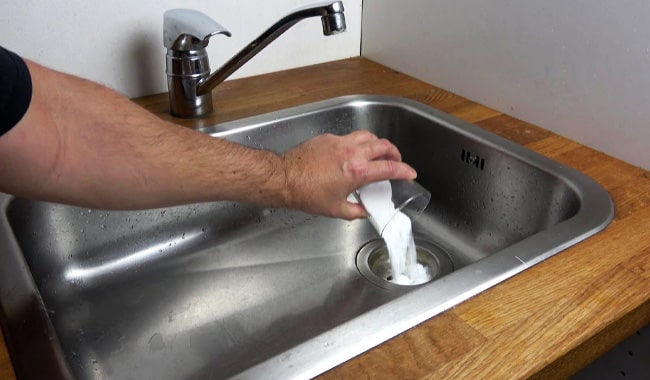
Once you remove the excess water from the sink, consider pouring one cup of baking soda into the sink drain.
Then pour another cup of apple cider vinegar in the same place. This solution will make a bubble. When you see subside, consider putting the stopper, and then wait for 10 to 15 minutes.
Again, pour boiled water in the sink and see if it works. You may need to repeat the process to effectively unclog the sink.
Method 3: Using a Plunger
If the above solutions don’t work for you, try using a household plunger. And if there is a double sink in your kitchen, consider sealing off its second side using a stopper or wet cloth.
Create a tight seal all around the plunger. There should be enough water on the sink to cover the bell that you want to plunge.
When all are set, firmly place the plunger over the sink drain, and forcefully plunge a few times. If this suction clears the clog, then, remove the plunger and pour and flash boiled water in the sink.
Method 4: P-Trap
Sometimes it’s the P-trap that causes such an issue. You can locate this P-trap underneath the sink. Before proceeding, place a bucket under the drain that will collect the debris or water that falls out of it.
Simply loosen the P-trap, and clear everything that is stuck into it. Tighten it and run warm water through it. You may need to replace the P-trap if necessary.
Final Words
Standard sink drain size makes it a lot easier for DIYers to do the plumbing work on their own. People often get confused and frustrated when they see there are various sizes for the drain. The standardized size clears all the confusion.
If your sink is clogged or you need to replace the drain or drain pipe, go to any local hardware store to get the proper size.
For the clogged sink, be sure to check if the garbage disposal is okay or not. In most cases, clogged disposal creates such an issue.
Happy Plumbing 🙂
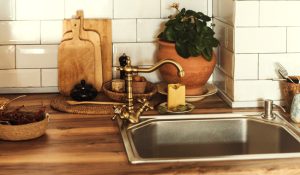
Is It Worth Buying an Expensive Kitchen Faucet?
When you are shopping for a new kitchen faucet, you may come across some pricey options that range between $500 and $1,000, or even more.
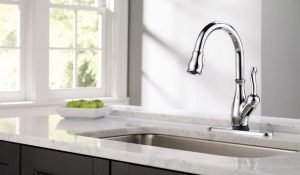
Delta Faucet 9178T-AR-DST Kitchen Sink Faucet Review
Whenever you are thinking about installing a new faucet or replacing the old one then you might need some proper idea about the faucet you
Kitchen Faucet Brands To Buy and Avoid | [Penny and Time Saved]
In our kitchen faucet buying guide we have shared lot of things you must consider while purchasing the best kitchen faucet. You’ll get numerous kitchen
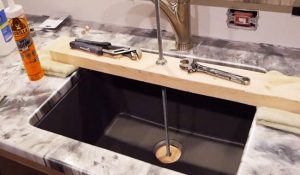
How to Install an Undermount Sink to a Granite Countertop
Plumbers are becoming expensive to hire for installing an undermount sink and it becomes costly for us. How it feels if you install it on your

Grohe Vs Kohler | Which Brand is Best for You?
Grohe and Kohler are considered to be stiff competitors to one another. Both the brands offer the best quality products according to their focus area.

How do You Measure a Kitchen Sink to Replace It
Measuring the size is a fundamental issue when you need to buy or replace a kitchen sink. Imagine you went to buy a sink and

